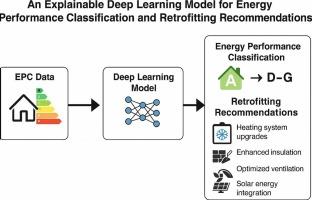一个可解释的深度学习模型,用于能源性能分类和改造建议
IF 7.1
2区 工程技术
Q1 CONSTRUCTION & BUILDING TECHNOLOGY
引用次数: 0
摘要
节能建筑改造对于减少碳排放和提高可持续性至关重要。本研究提出了一种新的基于深度学习的可解释人工智能模型,用于能效分类和改造建议。我们的模型集成了一个神经网络,具有L2正则化,辍学层,学习率调度和用于类平衡的合成少数过采样技术,确保鲁棒泛化。该模型在来自EPC数据集-意大利伦巴第地区的大量建筑数据集上进行训练,将结构分为节能(A4)和非节能(D-G)类。该模型的测试准确率达到99.95%,超过了文献中传统的机器学习和混合人工智能方法。此外,它通过结合基于shap的可解释性来解释模型决策并确定影响能源效率的关键因素,从而提供了更高的准确性。反事实的解释提供了个性化的改造建议,重点是绝缘、可再生能源的采用和高效的照明解决方案。本研究的见解提供了一个透明的、可解释的人工智能模型,支持决策者、政策制定者和利益相关者优化可持续城市发展的改造战略。本文章由计算机程序翻译,如有差异,请以英文原文为准。

An explainable deep learning model for energy performance classification and retrofitting recommendations
Energy-efficient building retrofitting is crucial in reducing carbon emissions and enhancing sustainability. This study presents a novel Deep Learning-based Explainable AI model for energy efficiency classification and retrofit recommendation. Our model integrates a neural network with L2 regularisation, dropout layers, learning rate scheduling, and the Synthetic Minority Over-sampling Technique for class balancing, ensuring robust generalisation. The model is trained on an extensive dataset of buildings from the EPC Dataset − Region Lombardy, Italy, classifying structures into energy-efficient (A4) and non-energy-efficient (D-G) classes. The proposed model achieved a test accuracy of 99.95%, surpassing conventional machine learning and hybrid AI approaches in the literature. Additionally, it provides more accuracy by incorporating SHAP-based explainability to interpret model decisions and identify the key factors influencing energy efficiency. Counterfactual explanations provide personalised retrofit recommendations, focusing on insulation, renewable energy adoption, and efficient lighting solutions. The insights from this study provide a transparent, interpretable AI model that supports decision-makers, policymakers, and stakeholders in optimising retrofitting strategies for sustainable urban development.
求助全文
通过发布文献求助,成功后即可免费获取论文全文。
去求助
来源期刊

Energy and Buildings
工程技术-工程:土木
CiteScore
12.70
自引率
11.90%
发文量
863
审稿时长
38 days
期刊介绍:
An international journal devoted to investigations of energy use and efficiency in buildings
Energy and Buildings is an international journal publishing articles with explicit links to energy use in buildings. The aim is to present new research results, and new proven practice aimed at reducing the energy needs of a building and improving indoor environment quality.
 求助内容:
求助内容: 应助结果提醒方式:
应助结果提醒方式:


